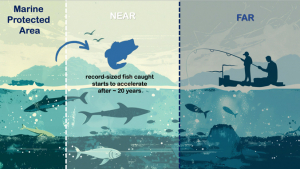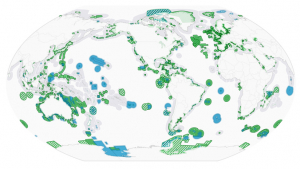
Marine Protected Areas (MPAs) are having a positive spillover effect, producing more “trophy-size” fish just outside of the fully protected areas, and the effect is growing stronger over time. That’s according to research led by University of Hawaiʻi at Mānoa scientists at the Hawaiʻi Institute of Marine Biology (HIMB) published in Science Advances. The research provides the first global assessment of the benefits of MPAs. “Trophy-size” refers to fish that are exceptionally long or heavy and are considered a rare, prized catch.
“This standardized global assessment illustrates the benefits that MPAs provide for recreational anglers, confirming the effectiveness of MPAs in enhancing fish biomass and local fisheries,” shared Simone Franceschini, principal investigator of the study and a postdoctoral researcher at HIMB. “Our study found that MPAs may take more than 20 years to show tangible spillover effects in the adjacent areas, which helps to set realistic expectations about the timeframe over which a marine reserve can be expected to have this type of effect on surrounding fisheries.”

The Hawaiian archipelago has 13 state and federal Marine Protected Areas (complete list below). The state protected areas, called Marine Life Conservation Districts, are managed by the State of Hawaiʻi Division of Aquatic Resources.
Long-term expectations for MPAs
MPAs have been identified as one of the most effective tools for securing marine biodiversity, but until now the global impact of MPAs on local, recreational fisheries has been unclear. This study provides globally relevant guidance for what management agencies, conservation practitioners, and, importantly, recreational fishers can expect over the long term from the establishment of MPAs.
The research builds on the work by scientists who conducted a study in Florida 20 years ago and discovered that the cumulative number of trophy fish caught near an MPA (within 100km of its boundary) rises rapidly between 12–30 years after MPA establishment.

“In this paper, we test whether the results of one of the most well-known studies of MPA impacts on recreational fishers can be replicated at a global scale,” explains Elizabeth Madin, co-author of the paper and associate professor at HIMB. “We show that, on average, highly-protected marine ecosystems produce tangible, real-world, long-term benefits for recreational fishers, resulting in a win-win situation for nature and people alike. Nonetheless, it’s important to realize that not every MPA will have the same spillover effects, and that successful MPAs have been shown to depend on community support, enforcement, and effective fisheries management.”
The findings of this study hold important implications for the future of MPAs and the global “30×30” marine conservation initiative, which aims to protect 30% of the world’s oceans by 2030.
“These results provide evidence-based guidance that can help ensure the successful implementation and long-term support of MPAs worldwide,” said co-author John Lynham, who is a UH Mānoa professor of economics. “It’s intriguing to note that various MPAs around the world, despite their differing sizes and characteristics, have demonstrated a similar positive spillover effect and a similar ‘wait time:’ roughly 20 years.”
The study also underscores the importance of setting practical expectations about the benefits of marine reserves for local fisheries. While MPAs can lead to substantial increases in the abundance of large fish, these benefits often require decades to materialize. This requires patience and long-term commitment from policymakers and local communities to maintain support for conservation efforts. Nonetheless, as Callum Roberts, lead author of the original 2001 study upon which the current study was built, points out, “Local fishers will see benefits to their catches from spillover of smaller fish long before that spillover becomes detectable in the form of large trophy fish, which take longer to reach record breaking sizes. So, well protected MPAs can help support local livelihoods within a decade of creation.”

